 |
| |
Britain's favourite horror-house shares some blood with its coolest spy, MI6 guest writer Mark Iveson spots the connections...
|
|
Bond Versus Hammer
10th June 2011
"My name is Bond - James Bond". That classic introduction to the cinema's greatest secret agent is as famous as "I am Dracula, I bid you welcome." When the box office success of "Dr No" (1962) turned the unknown Sean Connery into a movie legend, Hammer was never far away from the franchise. With their own films running parallel to the Bond series, Hammer and Eon Productions often made use of the same talent.
Rising from the sea in her legendary bikini, the impossibly beautiful Ursula Andress is the definitive Bond girl Honey Ryder. During her brief film stardom, she landed her other famous role as Ayesha in Hammer's "She" (1965). Playing Sylvia Trench, 007's first female conquest, was Eunice Gayson, best known to horror fans as Margaret in "Revenge of Frankenstein" (1958).
"Dr No" also marked the debuts of Bernard Lee (the first of 11 films as M) and Lois Maxwell (the first of 14 as Miss Moneypenny). Lee had a brief turn as Tarmut in Frankenstein and the Monster from Hell (1973) and despite never starring in a Hammer horror, Maxwell turned up in their early fifties thrillers "Lady in the Fog" (1953) and "Mantrap" (1954).
As doomed double-agent Professor Dent, Anthony Dawson is best known as the vile Marquis in Curse of the Werewolf [1961]). Featuring as heavies were Anthony Chin ("The Abominable Snowman" [1958]) and Milton Reid ("The Camp on Blood Island" [1958], "Terror in the Tongs" [1960] and the mulatto in "Captain Clegg" [1962]).
Right: Ursula Andress in the now iconic scene from "Dr No". |
|
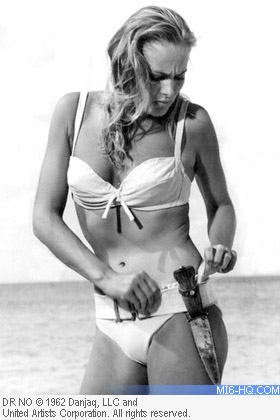
|
Lee and Maxwell reprised their roles in "From Russia with Love" (1963) with Gayson playing Sylvia one last time. Anthony Dawson also returns as the unseen Ernst Stavro Blofeld. More importantly this film marked the debut of Desmond Llewellyn in the first of 17 films as gadget man Q. His Hammer contribution consisted of bit parts in "The Sword of Sherwood Forrest" (1960) and "Curse of the Werewolf".
Other Hammer faces included Walter Gotell as Blofeld's head of training Mozerny; he turned up in "The Two Faces of Dr Jekyll" (1961) and "The Damned" (1963), and would become a permanent fixture in the series a decade later. Hammer regular Francis de Wolff hams it up as an unintelligible gypsy chief and Martine Beswick ("One Million Years BC" [1966], "Slave Girls" [1967] and "Dr Jekyll and Sister Hyde" [1971]) has a memorable turn as a hot headed gypsy girl.
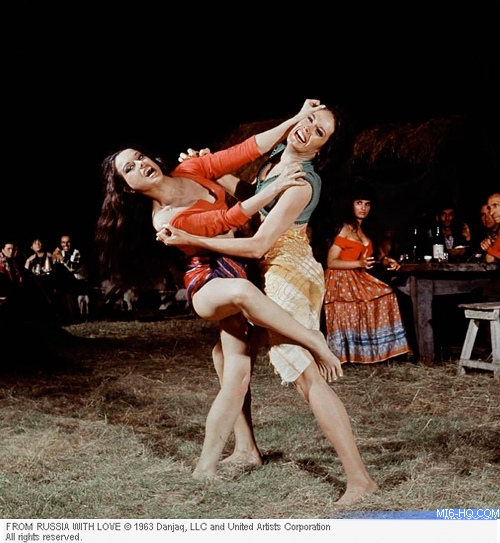
Above: Zora and Vida fight in the gypsy camps, as 007 looks on.
|
George Pastell (the high priests from "The Mummy" [1959] and "Curse of the Mummy's Tomb" [1964]) plays a train conductor, Vladek Sheybal, as SPECTRE villain Kronstein, starred in "The Lady Vanishes" (1979) and Peter Bayliss ("Frankenstein Created Woman" [1967] and "Frankenstein and the Monster from Hell") had a tiny role up as a chess player.
Now established as Q in "Goldfinger" (1964), Desmond Llewellyn formed an unbreakable link with Maxwell and Lee. Anthony Chin returns to the series as another heavy and Shirley Eaton, now best known for her gold painted death, was gorgeous eye candy in the Hammer comedies "Further Up the Creek" (1958) and "Weekend with Lulu" (1959).
As the improbably named Pussy Galore, Honor Blackman's first Hammer film was the fifties thriller "The Glass Cage" (1953); she turned up years later in "To the Devil, a Daughter" (1975). Of the character actors who feature in "Goldfinger", Martin Benson was the creepy Mr Rash in "Captain Clegg", Richard Vernon played downtrodden bank clerk "Hepburn in Cash of Demand" (1963) and Colonel Matthews in "The Satanic Rites of Dracula" (1973) and Burt Kwouk turned up as wily oriental types in "Yesterday's Enemy" (1958) "Terror in the Tongs and Visa to Canton" (1961).
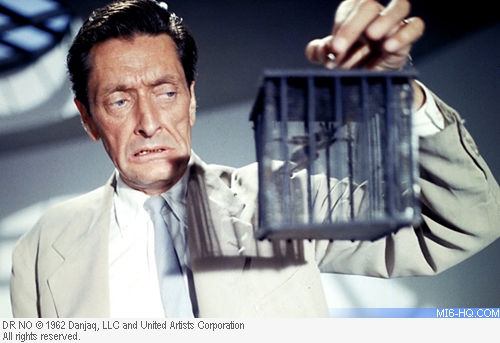
Above: Anthony Dawson's only 'complete' on-screen 007 appearance as Professor Dent in "Dr No".
|
"Thunderball" (1966) marked Anthony Dawson's last appearance as Blofeld and also making her final bow was Martine Beswick in a larger but less effective role of CIA agent Paula Caplan. Edward Underdown ("Camp on Blood Island"), Leonard Sachs ("A Taste of Fear" [1960]), Michael Brennan ("Lust for a Vampire" [1970]), George Pravda ("Frankenstein Must Be Destroyed" [1969]) and Patrick Holt ("The Men of Sherwood Forest" [1954], "The Stranger Came Home" [1954], "Further Up the Creek", "The Creatures the World Forgot" [1968]) also make brief appearances.
For Sean Connery's penultimate Bond, "You Only Lived Twice" (1967), Burt Kwouk and Anthony Chin return as Oriental heavies. There are fewer faces than before although Charles Gray, unforgettable as Mocata in "The Devil Rides Out" (1968) makes his debut as MI6 contact Henderson, and horror great Donald Pleasence puts in a belated but memorable appearance as Blofeld. Considering his reputation in the horror genre, his only Hammer film was the crime thriller "Hell is a City" (1959). Playing Pentagon officials are William Sylvester ("The Stranger Came Home") and Alexander Knox ("The Damned").
As the sixties closed, "On Her Majesty's Secret Service" (1969), starring George Lazenby as 007, featured a string of Bond babes with Hammer links. As the 'Angels of Death', they are Catherine Schell ("Moon Zero Two" [1969]), Julie Ege ("The Creatures the World Forgot", "Legend of the Seven Golden Vampires" [1974]), Joanna Lumley ("The Satanic Rites of Dracula"), Anouska Hempel and Jenny Hanley (both "Scars of Dracula" [1970]).
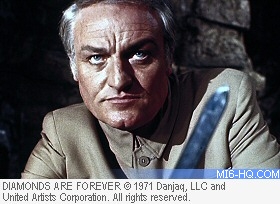
Above: Charles Grey as Blofeld.
|
|
Connery's return to Bond in "Diamonds Are Forever" (1971) marked a downturn in Hammer regulars. Apart from the always reliable Lee, Maxwell and Llewellyn, the only other returning actor is Charles Gray, as a fine, if rather camp Blofeld.
The dry spell continued with Roger Moore's 007 debut in "Live and Let Die" (1973); even Desmond Llewellyn is unforgivably absent from this one. As the first Bond girl he seduces, Madeline Smith earned her cult spurs in "Taste the Blood of Dracula" (1969), "The Vampire Lovers" (1970) and Frankenstein and the Monster from Hell. |
In addition to bringing Desmond Llewellyn back, "The Man with the Golden Gun" (1974) is notable for Christopher Lee's brilliant turn as Scaramanga. It certainly helped him move away from horror to more eclectic film work. The Hammer link improves slightly with Marne Maitland ("I Only Asked" [1958], "Terror in the Tongs" and the creepy Malay servant in "The Reptile" [1966]), James Cossins ("The Anniversary" [1968], "The Lost Continent" [1968] and "Fear in the Night" [1972]) and Michael Goodliffe ("The Gorgon" (1964), "To the Devil, a Daughter") in smaller roles.
"The Spy Who Loved Me" (1977) is packed with Hammer regulars. In addition to Milton Reid's one-off return to the series as a heavy, Walter Gotell reappears as KGB head General Anatol Gogal, a part he played in the next five films.
One new face is Geoffrey Keen as Defence Minister Frederick Gray, a part he played in the next five films. His Hammer contribution includes "Lady in the Fog" (1954) "Face the Music" (1954) and "The Glass Cage", but he is best known as the repulsive Hargood in "Taste the Blood of Dracula". Robert Brown also debuts as Admiral Hargreaves. A Hammer veteran with "Death of an Angel" (1952), "The Steel Bayonet" (1957), "The Abominable Snowman" and "One Million Years BC" and "Demons of the Mind" (both 1972), he eventually replaced Bernard Lee as M.
The Hammer glamour is brilliantly represented by the lovely Caroline Munro as the deadly Naomi. Who could forget her sexy presence in "Dracula AD 1972" (1972) and "Captain Kronos Vampire Hunter" (1973)?
Smaller roles were taken by Edward de Souza (the bland hero of "Kiss of the Vampire" [1963] and "The Phantom of the Opera" [1962]), Valerie Leon ("Blood from the Mummy's Tomb" [1971]), Sidney Tafler ("Weekend with Lulu"), Bryan Marshall ("The Witches" [1966] "Quatermass and the Pit" [1967]), Barry Andrews ("Dracula Has Risen from the Grave" [1968]) and Jeremy Bulloch ("The Lady Vanishes").
"Moonraker" (1979) is notable for being Bernard Lee's final appearance as M. Other than establishing Gotell and Keen in their recurring roles, the only Hammer link comes from comic actors Alfie Bass ("I Only Asked", "A Challenge for Robin Hood" [1967]) and Arthur Howard ("I Only Asked").
Right: Caroline Munro, the lovely-lined villainess. |
|
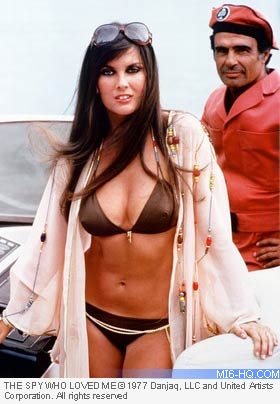
|
Things are looking up in "For Your Eyes Only" (1981) with Julian Glover AKA Colonel Breen in "Quatermass and the Pit" making an effective Bond villain. Also appearing were Jack Hedley ("The Anniversary"), Jill Bennett ("The Nanny" [1965]) and James Villiers (the sadistic Corbeck in "Blood From the Mummy's Tomb") as Bill Tanner; Jeremy Bulloch also returns to the series as Q's assistant Smithers.
"Octopussy" (1983) marked Robert Brown's return to the series as M in a cast that included Douglas Wilmer ("Baron Hartog in The Vampire Lovers") and Steven Berkoff ("Slave Girls"). Jeremy Bulloch makes his second and final appearance as Smithers. For good measure Ingrid Pitt's voice is used for a tannoy announcement!
"A View to a Kill" (1985) is notable as the final film for Lois Maxwell. Also returning for his fourth and final bit part was Anthony Chin. Patrick MacNee, who had a tiny role in the early Hammer feature "Dick Barton at Bay" (1948) is the only new face.
The Hammer link dwindled severely when Timothy Dalton took over as 007 in "The Living Daylights" (1987). Walter Gotell and Geoffrey Keen left the series after this film with Robert Brown's swansong taking place in "Licence to Kill" (1989). Llewellyn carried on in both films with the latter featuring Christopher Neame AKA Johnny Alucard from "Dracula AD 1972" as M16 agent Carstairs.
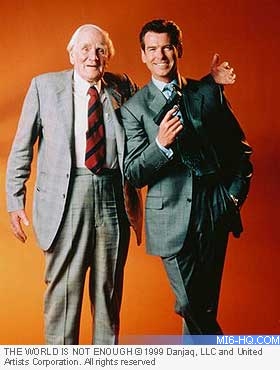
|
|
Neame's "AD 72" co-star Michael Kitchen (as Bill Tanner) joined the cast alongside Desmond Llewellyn for Pierce Brosnan's debut as Bond in "GoldenEye" (1995). He was absent from "Tomorrow Never Dies" (1997) but returned to the series one more time in "The World is Not Enough" (1999).
Llewellyn's death shortly after "The World is Not Enough" effectively ended the cinema association. In terms of television, there was an episode from "The Hammer House of Horror" series entitled "The Carpathian Eagle" in which an unknown Pierce Brosnan plays a murder victim. Tenuous to say the least, but it allows the Hammer link to continue up to Brosnan's final 007 outing "Die Another Day" (2002). Brosnan's departure from the series permanently severed the Hammer/007 link, with no further crossovers during the Daniel Craig era.
Right: Desmond Llewelyn and Pierce Brosnan pose for a special shoot on what would be Q's final film. |
Thanks to Mark Iveson. First Published on Shadowlocked.